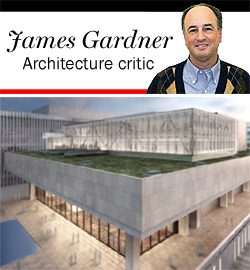Trending
Claire Tow Theater at Lincoln Center will add a certain charm
As desecrations go, the nearly completed Lincoln Center Theater 3, which sits atop the Vivian Beaumont Theatre, is turning out rather well. The last time we looked at it, nearly two years ago, it was merely a promise. Now that promise is nearing fulfillment.
Designed by Hugh Hardy of H3 Hardy Collaboration Architecture (who helped with the Vivian Beaumont design in years past), it rises over the austerely modernist pile that was conceived by Eero Saarinen (primarily) in 1965. The overhaul is scheduled for completion in March of next year, at a cost of $41 million.
In the recent renovations to the Lincoln Center campus, no area has been disrupted more often or more fundamentally than the spaces around the Vivian Beaumont. The Plaza, a cool exercise in pure geometry has seen its fountain, inhabited by a Henry Moore sculpture, thoroughly subverted and reconceived, while a curving earthwork has been shoe-horned into the narrow space immediately to the north. As a result of these modifications, the space is surely more lively and popular with the general public, but the purity of its modernist ideas has been dealt a serious blow.
The new addition, which will be known as the Claire Tow Theater once completed next year, is a 23,000-square-foot, 131-seat box that will also include offices for LCT3, which is generally considered a younger and more daring theater experience than the more conservative fare of the Vivian Beaumont. A rectilinear structure, it sits on the roof of the Vivian Beaumont, surrounded by grass and often seems to struggle to be as undisruptive as possible, by fading into the fabric of this building. For the moment it stands as a slightly darkened curtain wall, but when it is covered over in pale brise-soleil bars, the harmony of its integration will be clearer.
At the same time, the new addition, seen from certain angles, asserts itself over the square space that spreads out directly below. Something of the massive simplicity of the original structure has been lost, but the case could be made that the resulting rhythms add a certain charm and monumentality to the building, which has gone from being — in visual terms — a lintel on a cornice to a three-fold structure that recalls a triumphal arch.





